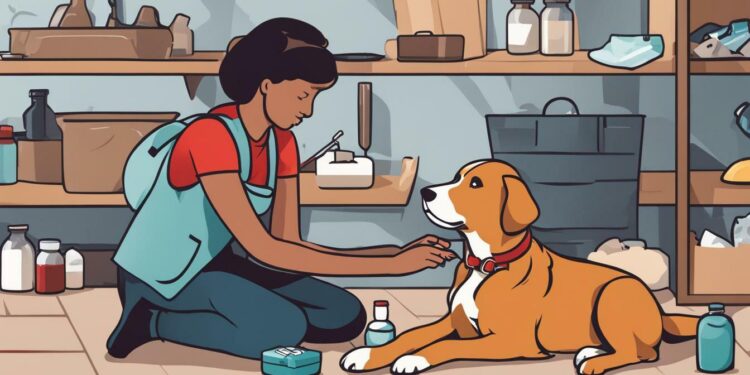Dog First Aid: Crucial Tips Every Canine Owner Should Know

As a responsible canine owner, it’s crucial to equip yourself with essential dog first aid tips to ensure the health and safety of your beloved pet. Knowing basic first aid information and being prepared for emergencies can help you avoid panic in critical situations with your dog. It is important to have a pet first aid kit, the phone numbers of your veterinarian, the national animal poison control hotline, and a 24-hour emergency veterinary hospital.
In case of an injury, avoid hugging or getting too close to your pet’s mouth to protect yourself. Some common emergencies that may require first aid include choking, poisoning, cuts, car trauma, seizures, and overheating. It is important to have the right supplies, such as gauze, non-stick bandages, adhesive tape, eye dropper, muzzle, leash, and a stretcher.
Always be prepared and keep a list of important phone numbers for emergencies. Remember that first aid is not a substitute for veterinary care, and immediate veterinary attention should follow any first aid given to your pet.
Importance of Pet First Aid Preparedness
Being prepared for emergencies is the key to effective pet first aid, ensuring timely intervention and potentially saving your dog’s life. As a responsible canine owner, it is crucial to have a well-stocked pet first aid kit and the necessary knowledge to handle common emergencies.
Building your Pet First Aid Kit: A properly equipped pet first aid kit is essential for addressing injuries and providing immediate care before professional help is available. Some important supplies to include are gauze, non-stick bandages, adhesive tape, eye dropper, muzzle, leash, and a stretcher. Keep your first aid kit easily accessible in case of an emergency.
| Essential Pet First Aid Kit Supplies |
|---|
| Gauze |
| Non-stick bandages |
| Adhesive tape |
| Eye dropper |
| Muzzle |
| Leash |
| Stretcher |
Important Contact Numbers: In case of an emergency, having the phone numbers of your veterinarian, the national animal poison control hotline, and a 24-hour emergency veterinary hospital readily available can make a significant difference. Place these numbers in your pet first aid kit and keep a written copy in an easily accessible location, such as on your refrigerator.
“The safety and well-being of your dog depend on your preparedness. Having a pet first aid kit and important contact numbers at your fingertips can make all the difference in critical situations.” – Dr. Emily Andrews, Veterinarian
Remember, while first aid knowledge is vital, it should never replace professional veterinary care. First aid is intended to provide immediate assistance in emergencies, but it is essential to seek veterinary attention following any first aid administered to your pet. Establishing a good relationship with a trusted veterinarian ensures that your dog’s health is properly managed in the long run.
Building a well-stocked pet first aid kit is essential for promptly attending to your dog’s injuries in emergency situations. When assembling your pet first aid kit, it is crucial to include the necessary supplies to handle a variety of injuries. Here are some key items to consider including:
1. Gauze and non-stick bandages: These are essential for cleaning and covering wounds to prevent infection. Make sure to have different sizes available to accommodate various injuries.
2. Adhesive tape: Use this to secure bandages in place, ensuring they stay in position and provide adequate protection.
3. Eye dropper: This can be useful for administering medication or flushing your dog’s eyes in case of irritation or injury.
4. Muzzle: In emergency situations, even the most well-behaved dogs can become scared or injured, increasing the risk of aggressive behavior. Having a muzzle on hand can help prevent potential bites and keep both you and your pet safe.
5. Leash: A sturdy leash is a must-have item in your pet first aid kit. It will allow you to safely control your dog’s movements during emergencies or when seeking medical attention.
6. Stretcher: In cases where your dog cannot walk or needs to be carried due to an injury, having a stretcher can make transportation easier and more comfortable for your pet.
Remember to periodically check and replenish your pet first aid kit to ensure that all supplies are up-to-date and in good condition. Additionally, keep a list of important phone numbers, including your veterinarian, the national animal poison control hotline, and a 24-hour emergency veterinary hospital.
Building a well-stocked pet first aid kit and being prepared for emergencies can significantly increase your ability to provide initial care to your dog in critical situations. However, it is important to remember that first aid is not a substitute for professional veterinary care. Always seek immediate veterinary attention following any first aid administered to your pet.
Handling Injuries and Wounds
Knowing how to appropriately handle injuries and wounds in dogs is vital to prevent further harm and promote quick healing. In case your canine companion experiences a cut, it is important to take immediate action to ensure their safety and wellbeing.
To effectively handle cuts in dogs, follow these steps:
- Keep yourself and your dog calm. Assess the severity of the cut and check for any signs of excessive bleeding or foreign objects embedded in the wound.
- If the bleeding is severe, apply gentle pressure to the wound using a clean towel or gauze pad. This can help control the bleeding until you can seek veterinary assistance.
- Clean the wound using a mild antiseptic solution or clean water. Avoid using hydrogen peroxide or alcohol as they can damage the healthy tissues.
- Apply a non-stick bandage or gauze pad to cover the wound. Secure it in place using adhesive tape or an elastic bandage. Be cautious not to wrap it too tightly as it may restrict blood flow.
If the cut appears deep, is accompanied by excessive bleeding, or if you are unsure about how to handle the situation, it is crucial to seek immediate veterinary care. Remember, professional medical attention should always follow any first aid given to your pet.
| Supplies Checklist: | Additional Tips: |
|---|---|
| Gauze pads | Place a muzzle on your dog if necessary to prevent biting during treatment. |
| Non-stick bandages | Keep your dog calm and relaxed to minimize stress and discomfort. |
| Adhesive tape | Avoid the use of human medications unless specifically recommended by a veterinarian. |
| Clean towel | Always consult with your veterinarian for further guidance and follow-up care. |
Having a well-stocked pet first aid kit ready can significantly help in managing injuries and wounds effectively. Remember to periodically check and replenish the supplies to ensure their readiness in times of need. By being prepared and equipped with basic first aid knowledge, you can provide immediate care to your dog and potentially prevent further complications.
Dealing with Choking Emergencies
Choking emergencies can occur unexpectedly, but with the right knowledge and quick action, you can effectively assist your dog and potentially save its life. Dogs are curious creatures that sometimes end up swallowing objects that can obstruct their airways. It is crucial to remain calm and follow these steps to help your choking dog:
- If your dog is still conscious and coughing, encourage them to continue coughing to try and dislodge the object on their own. Do not intervene unless the coughing becomes ineffective or your dog is unable to breathe.
- If your dog is unable to cough or breathe, perform the Heimlich maneuver. Stand behind your dog and place your hands just below the ribcage. Make a fist with one hand and cover it with your other hand. Give firm, upward abdominal thrusts to exert pressure and assist in dislodging the object. Be mindful not to apply excessive force.
- If the Heimlich maneuver is unsuccessful, you may need to perform a modified version on smaller dogs or give back blows and chest compressions in severe cases. It is essential to learn and practice these techniques to be prepared for such emergencies.
| Important Steps for Dealing with Choking Emergencies |
|---|
| • Stay calm and assess the situation. |
| • Encourage coughing if your dog is conscious and coughing. |
| • Perform the Heimlich maneuver if necessary. |
| • Seek veterinary attention even if the object is dislodged. |
Remember, even if you manage to dislodge the object and your dog seems fine, it is crucial to seek veterinary attention. A professional evaluation will ensure there are no underlying injuries or complications. Keep in mind that prevention is always the best approach, so be cautious of the objects your dog has access to, particularly small toys, bones, or items they may swallow accidentally. By staying vigilant and informed, you can be prepared to handle choking emergencies and provide immediate assistance to your beloved companion.
Recognizing and Responding to Poisoning
Promptly recognizing the signs of poisoning in dogs and taking immediate action is vital to ensure their safety and well-being. Dogs are curious animals, and they may inadvertently come into contact with toxic substances both indoors and outdoors. As a responsible dog owner, it’s crucial to be aware of the signs of poisoning and know how to respond effectively.
Table: Signs of Poisoning in Dogs
| Signs of Poisoning | Actions to Take |
|---|---|
| Vomiting, diarrhea, or excessive drooling | Call your veterinarian or the animal poison control hotline immediately for guidance. |
| Weakness, lethargy, or collapse | Remove your dog from the source of poisoning and seek immediate veterinary attention. |
| Rapid breathing or difficulty breathing | Keep your dog calm and transport them to a veterinary clinic without delay. |
| Seizures, tremors, or abnormal behavior | Contact a veterinarian or emergency veterinary hospital right away for assistance. |
If you suspect your dog has ingested a potentially toxic substance, it’s essential to contact your veterinarian or the national animal poison control hotline immediately. They can provide expert advice and guide you through the necessary steps to take. While waiting for professional help, do not attempt to induce vomiting unless instructed to do so by a veterinarian, as some substances can cause further damage if regurgitated.
Quote: “Prompt action is critical in cases of poisoning in dogs. By being vigilant and recognizing the signs early on, you can help save your pet’s life.” – Dr. Sarah Thompson, Veterinarian
Handling Car Trauma and Accidents
Accidents involving cars can lead to severe injuries in dogs, and knowing how to respond in such situations can make a significant difference in their recovery. The first step is to ensure your safety and the safety of others around you before approaching the injured dog. Use caution and be aware that injured dogs may respond differently due to fear, pain, or disorientation.
Once you have ensured your safety, it is important to assess the dog’s condition. Look for any visible injuries, including bleeding, broken bones, or difficulty breathing. If the dog is conscious, it is best to approach slowly and calmly, speaking in a soothing tone to help alleviate their anxiety.
If the dog is unconscious or experiencing difficulty breathing, it may be necessary to gently move them to a safer location off the road. To do this, you can slide a blanket, towel, or piece of cardboard underneath the dog and carefully drag them to safety. Avoid pulling on their limbs or applying pressure to any injured areas.
Once the dog is in a safe area, it is crucial to contact a veterinarian immediately for further guidance. Describe the situation and the dog’s condition in detail to ensure appropriate advice. Remember, first aid can only provide temporary relief, and professional veterinary care is necessary for a proper diagnosis and treatment plan.
| Key Points for Handling Car Trauma and Accidents: |
|---|
| 1. Ensure your safety and the safety of others before approaching the injured dog. |
| 2. Assess the dog’s condition for visible injuries and signs of distress. |
| 3. Approach slowly and calmly, speaking in a soothing tone to alleviate the dog’s anxiety. |
| 4. If necessary, move the dog to a safer location using a blanket or towel. |
| 5. Contact a veterinarian immediately for further guidance and professional care. |
Managing Seizures in Dogs
Witnessing your dog experience a seizure can be distressing, but knowing how to provide immediate care and when to seek veterinary attention is crucial. Seizures in dogs can be caused by various factors, such as epilepsy, brain tumors, or toxic substances. While some seizures may be short and mild, others can be prolonged and severe, posing a significant risk to your dog’s health.
During a seizure, it is important to prioritize your dog’s safety and provide a calm and safe environment. Remove any nearby objects that could potentially harm your dog, but avoid restraining them or placing your hands near their mouth to prevent accidental bites. It is recommended to time the duration of the seizure as it can provide valuable information to your veterinarian.
If your dog experiences a seizure for the first time, it is essential to seek immediate veterinary care. Your veterinarian will evaluate your dog’s condition, perform any necessary diagnostic tests, and develop an appropriate treatment plan. In some cases, anti-seizure medications may be prescribed to help manage and reduce the frequency of seizures.
Signs of a seizure in dogs may include:
- Loss of consciousness
- Tremors or convulsions
- Stiffening of the body
- Uncontrolled urination or defecation
- Excessive drooling or foaming at the mouth
| Emergency Actions: | When to Seek Veterinary Attention: |
|---|---|
|
|
Remember, while providing immediate care during a seizure is important, it is equally crucial to seek veterinary attention promptly. Your veterinarian will be able to properly diagnose the underlying cause of the seizure and recommend appropriate treatment options to ensure your dog’s well-being.
Preventing and Managing Overheating
Dogs are susceptible to overheating, especially during hot weather, and it’s essential to take preventive measures and respond promptly to signs of heatstroke to protect their health. Here are some crucial tips to help you prevent and manage overheating in your furry companion.
Recognizing the Signs of Heatstroke
Being able to identify the signs of heatstroke is vital for early intervention and preventing serious health complications. Look out for symptoms such as excessive panting, drooling, weakness, vomiting, diarrhea, rapid heartbeat, and collapse. If you notice any of these signs, it’s important to act quickly to cool down your dog and seek veterinary assistance.
Keeping Your Dog Cool
There are several measures you can take to keep your dog cool and prevent overheating. Ensure they always have access to fresh water, both indoors and outdoors. Provide shaded areas for them to rest and avoid prolonged exposure to direct sunlight. Avoid excessive exercise during hot weather, and opt for walks and playtime during cooler times of the day, such as early morning or evening. You can also use cooling products like gel pads or vests to help regulate their body temperature.
Responding to Heatstroke
If your dog is experiencing heatstroke, it’s crucial to act swiftly to prevent further complications. Move them to a cool, shaded area and apply cool (not cold) water to their body, focusing on the neck, belly, and paw pads. You can also use wet towels or spray mist to help lower their body temperature. Avoid using ice-cold water or submerging them in cold water, as this can cause shock. After providing initial first aid, seek immediate veterinary attention to ensure proper diagnosis and treatment.
| Preventive Measures | Signs of Heatstroke | Response to Heatstroke |
|---|---|---|
|
|
|
Remember, prevention is key when it comes to overheating. By following these preventative measures and being vigilant for signs of heatstroke, you can help keep your dog safe and ensure their well-being even during the hottest months of the year.
The Limitations of First Aid and Veterinary Care
While dog first aid skills are invaluable, it’s crucial to understand their limitations and ensure that your pet receives the necessary professional veterinary care. First aid knowledge and supplies can help stabilize your dog in an emergency situation, but they are not a substitute for proper medical treatment.
When administering first aid to your dog, it is important to remember that you are not a trained veterinarian. While you can provide immediate care such as stopping bleeding or preventing further injury, only a professional can diagnose and treat underlying medical conditions. It’s essential to seek veterinary attention as soon as possible, even if your dog seems stable after receiving first aid.
Additionally, some conditions may not present obvious symptoms or may require specialized equipment and expertise to diagnose. In these cases, relying solely on first aid can delay proper treatment and potentially worsen your dog’s condition. A veterinarian can conduct thorough examinations, perform diagnostic tests, and provide the appropriate medications or treatments for your dog’s specific needs.
Remember, prevention is key to keeping your dog healthy. Regular visits to a trusted veterinarian for check-ups and vaccinations are vital for maintaining your pet’s well-being. Veterinary care not only addresses existing health issues but also focuses on preventive measures to keep your dog protected from diseases and other potential hazards.
| Key Takeaways: |
|---|
| First aid skills are valuable for stabilizing your dog in emergencies but should not replace professional veterinary care. |
| Seek immediate veterinary attention after administering first aid to your dog, even if they seem stable. |
| A veterinarian can diagnose and treat underlying medical conditions that may not be apparent through first aid alone. |
| Regular check-ups and preventive care from a trusted veterinarian are essential for your dog’s overall health and well-being. |
Ensuring your dog receives proper veterinary care is a crucial part of being a responsible pet owner. While first aid skills can make a difference in an emergency, they should always be followed by professional medical attention. By understanding the limitations of first aid and prioritizing veterinary care, you can give your dog the best chance at a healthy and happy life.
Conclusion
By prioritizing dog first aid and being prepared for emergencies, you can provide the best possible care for your canine companion and safeguard their health and well-being. Knowing basic first aid information and having a pet first aid kit readily available can help you remain calm and take appropriate action in critical situations.
Always ensure that you have important contact numbers, including your veterinarian, the national animal poison control hotline, and a 24-hour emergency veterinary hospital. These numbers can be a lifeline during emergencies and provide guidance and immediate assistance when needed.
Remember to handle injuries and wounds with caution, avoiding direct contact with your pet’s mouth to prevent potential bites. Having the right supplies, such as gauze, non-stick bandages, adhesive tape, an eye dropper, a muzzle, a leash, and a stretcher, can make a significant difference when administering first aid to your dog.
It is crucial to understand that while first aid knowledge is essential, it should never replace professional veterinary care. After providing any form of first aid, it is imperative to seek immediate veterinary attention to ensure proper evaluation and treatment for your dog’s condition.
By being proactive, knowledgeable, and well-prepared, you can effectively respond to emergencies and give your beloved canine companion the care they need in times of distress. Stay informed, stay prepared, and prioritize your dog’s health and safety at all times.
FAQ
Q: Why is pet first aid preparedness important?
A: Pet first aid preparedness is crucial because it allows you to handle emergencies with your dog confidently and effectively. It can prevent further harm and potentially save your dog’s life.
Q: What should I include in my pet first aid kit?
A: Your pet first aid kit should include essential supplies such as gauze, non-stick bandages, adhesive tape, an eye dropper, a muzzle, a leash, and a stretcher. It is important to be prepared for various emergencies.
Q: How should I handle cuts and wounds in my dog?
A: When dealing with cuts and wounds, it is important to clean the area gently with clean water and apply a clean, non-stick bandage. Avoid direct contact with your dog’s mouth to prevent potential bites.
Q: What should I do if my dog is choking?
A: If your dog is choking, try to remain calm and perform the Heimlich maneuver carefully. This involves applying firm, upward pressure to the abdomen, just below the ribcage. Seek veterinary attention immediately.
Q: What should I do if I suspect my dog has been poisoned?
A: If you suspect poisoning in your dog, contact the national animal poison control hotline and seek immediate veterinary attention. Time is of the essence in these situations, and professional help should be sought as soon as possible.
Q: How should I handle car trauma and accidents involving my dog?
A: When dealing with car trauma and accidents, prioritize safety by securing the area and moving your dog carefully. Contact a veterinarian as soon as possible for further evaluation and treatment.
Q: How should I manage seizures in my dog?
A: During a seizure, create a safe environment by removing potential hazards. Remain calm and time the duration of the seizure. Contact your veterinarian for guidance and to discuss further evaluation and treatment options.
Q: How can I prevent and manage overheating in my dog?
A: Prevent overheating by providing shade, fresh water, and avoiding excessive exercise during hot weather. Recognize the signs of heatstroke, such as excessive panting and weakness, and seek veterinary care immediately if necessary.
Q: Can first aid replace veterinary care?
A: No, first aid is not a substitute for professional veterinary care. While it is important to know basic first aid techniques, immediate veterinary attention should always follow any first aid given to your dog.






